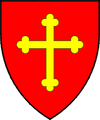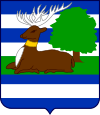Negoslavci
| Negoslavci Негославци (Serbian)[1] | ||
|---|---|---|
| Municipality | ||
|
Municipality of Negoslavci Općina Negoslavci | ||
 | ||
| ||
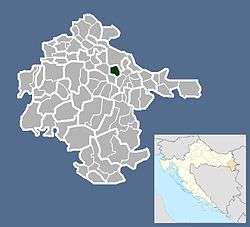 | ||
 Negoslavci Location of Negoslavci in Croatia | ||
| Coordinates: 45°17′N 19°00′E / 45.28°N 19°E | ||
| Country |
| |
| Region | Syrmia (Podunavlje) | |
| County |
| |
| Government | ||
| • Municipal mayor | Dušan Jeckov[2] (SDSS[2]) | |
| Area | ||
| • Total | 21.21 km2 (8.19 sq mi) | |
| Population (2011)[3] | ||
| • Total | 1,463 | |
| • Density | 69/km2 (180/sq mi) | |
| Time zone | UTC+1 (Central European Time) | |
| Postal code | 32 239 | |
| Area code(s) | 32 | |
| Vehicle registration | VU | |
| Official languages | Croatian, Serbian[4] | |
| Website | www.opcina-negoslavci.hr | |
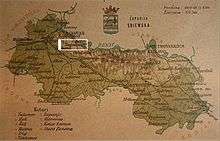
Negoslavci (Serbian Cyrillic: Негославци)[5] is a village and a municipality in Vukovar-Srijem County, Croatia.
Geography
Negoslavci municipality have total area of 21.21km2[6] and is the smallest member municipality of Joint Council of Municipalities. It is connected by D57 highway with rest of country.
History
Negoslavci village is mentioned in historical documents from the 15th century. The assumption is that there was also an ancient Roman settlement at this locality. During Austro-Hungarian administration, settlement of Negoslavci was the seat of the municipality, as was evidenced by the records from 1894. After World War II, the village was settled by the people from Bosnia and Herzegovina.
Demographics
Population
Negoslavci has 1,417 inhabitants, the majority of whom are Serbs, making up 96.86 percent of the population according to the 2011 population census. This makes Negoslavci the municipality with the largest percentage of Serbs in Croatia.
Languages
Due to the local minority population, the Negoslavci municipality prescribe the use of not only Croatian as the official language, but the Serbian language and Serbian Cyrillic alphabet as well.[7][8]
Politics
Multilateral cooperation
Negoslavci municipality is one of seven member municipalities of Joint Council of Municipalities, inter-municipal sui generis organization of Serbian community in eastern Croatia.
Municipality government
The municipality assembly is composed of 11 representatives. Assembly members come from electoral lists winning more than 5% of votes. Dominant party in Negoslavci since the reintegration of eastern Slavonia in 1998 is Independent Democratic Serb Party. 323 or 30,62 % out of 1,055 voters participated in 2017 Croatian local elections with 94,72 % valid votes.[9] With 96,28% and 311 votes Dušan Jeckov from Independent Democratic Serb Party was elected as municipality major.[9] As of 2017, the member parties/lists are:
Summary of 2017 Croatian local elections
| Party | Votes | % | Seats | ||||
|---|---|---|---|---|---|---|---|
| Independent Democratic Serb Party | 305 | 100,00 | 11 | ||||
| Invalid/blank votes | 17 | 5,28 | — | ||||
| Total | 322 ballots and 323 voters | 100 | — | ||||
| Registered voters/turnout | 1.055 | 30,52 % /30,62 % | — | ||||
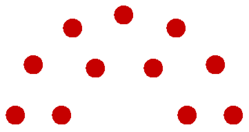 | |||||||
| Source: [9] page 59-60 (in Croatian) | |||||||
Economy
Negoslavci is underdeveloped municipality which is statistically classified as the First Category Area of Special State Concern by the Government of Croatia.[10] According to municipal mayor unemployment is one of the biggest problems of Negoslavci.[11]
Education
Elementary School in Negoslavci is established in 1761.[12] In 1981 was built new school building. Since 1992 school operates as an eight grade school, and due to increased number of students come to upgrade two classrooms with USAID funds.[12] Each year the school celebrates traditional feast slava dedicated to Saint Sava.[13] In 2011, during celebration of 250 anniversary, school issued Chronicle of elementary school in Negoslavci which was jointly funded by Vukovar-Srijem County, Joint Council of Municipalities, Negoslavci municipality, Prosvjeta, Serb National Council and other donors.[14]
Culture
Points of Interest
Church of the Assumption of the Blessed Virgin is a Serbian Orthodox church completed in 1757. There are two ossuaries from the period of World War II with the bones of Yugoslav Partisan fighters from the time of Syrmian Front.[15] First of the ossuaries state in Serbian Cyrillic script "In the glorious name of 40 fighters of the 1st Proletarian and 8th Montenegrin Brigade, the 1st Proletarian Division, who fell in 1944-1945 on the Syrmian Front for the freedom and the better future of their people."[15] On the second one with the unknown number of fighters there is Cyrillic inscription "You who have shed your blood, you who have given your young lives, You who have fall for the sake of freedom, We honor you with the greatest glory and thankfulness. Negoslavci Women's Section."[15]
Associations and institutions
In the village exist a volunteer fire department Negoslavci.[16]
Sport
The football team PZ Negoslavci is situated in this village. Football is the main sport played and possibly the only sport played.
Twin municipalities – Sister municipalities
Other forms of cooperation
See also
References
| Wikimedia Commons has media related to Negoslavci. |
- ↑ Government of Croatia (October 2013). "Peto izvješće Republike Hrvatske o primjeni Europske povelje o regionalnim ili manjinskim jezicima" (PDF) (in Croatian). Council of Europe. p. 36. Retrieved 30 November 2016.
- 1 2 "Informacija o rezultatima izbora članova predstavničkih tijela jedinica lokalne i područne (regionalne) samouprave" (PDF). Retrieved 2013-03-10.
- ↑ Croatian Bureau of Statistics. "2. STANOVNIŠTVO PREMA NARODNOSTI PO GRADOVIMA/OPĆINAMA, POPIS 2011" (in Croatian). Croatian Bureau of Statistics. Retrieved 25 August 2017.
- ↑ Četvrto izvješće Republike Hrvatske o primjeni Europske povelje o regionalnim ili manjinskim jezicima, page 61., Zagreb, 2009
- ↑ "Minority names in Croatia:Registar Geografskih Imena Nacionalnih Manjina Republike Hrvatske" (PDF). Archived from the original (PDF) on 2013-10-29. Retrieved 2013-03-08.
- ↑ http://www.vukovarsko-srijemska-zupanija.com/vsz.php?stranica=65
- ↑ Izvješće o provođenju ustavnog zakona o pravima nacionalnih manjina i o utošku sredstava osiguranih u državnom proračunu Republike Hrvatske za 2008. godinu za potrebe nacionalnih manjina, Zagreb, 2009.
- ↑ "Archived copy" (PDF). Archived from the original (PDF) on 2013-10-29. Retrieved 2013-03-08.
- 1 2 3 "Informacija o izborima članova predstavničkih tijela jedinica lokalne i područne (regionalne) samouprave i općinskih načelnika, gradonačelnika i župana te njihovih zamjenika - 2017 (Vukovarsko-srijemska županija)" (PDF) (in Croatian). Retrieved 15 January 2018.
- ↑ Lovrinčević, Željko; Davor, Mikulić; Budak, Jelena (June 2004). "AREAS OF SPECIAL STATE CONCERN IN CROATIA- REGIONAL DEVELOPMENT DIFFERENCES AND THE DEMOGRAPHIC AND EDUCATIONAL CHARACTERISTICS". Ekonomski pregled, Vol.55 No.5-6. Retrieved 25 August 2018.
- ↑ http://www.novossti.com/2010/05/zajedno-do-novca-iz-fondova-eu-a/
- 1 2 http://os-negoslavci.skole.hr/skola/povijest
- ↑ http://os-negoslavci.skole.hr/?news_hk=1&news_id=66&mshow=290#mod_news
- ↑ http://os-negoslavci.skole.hr/?news_hk=1&news_id=41&mshow=290#mod_news
- 1 2 3 "Generalni konzulat Republike Srbije u Vukovaru". Ministry of Foreign Affairs (Serbia). Retrieved 25 August 2017.
- ↑ "Archived copy" (PDF). Archived from the original (PDF) on 2012-04-30. Retrieved 2011-10-15.
- 1 2 3 4 "Novosti-Zajedno do novca iz fondova EU-a" (PDF). Retrieved 2013-03-13.
